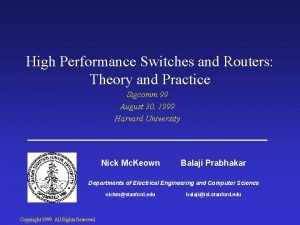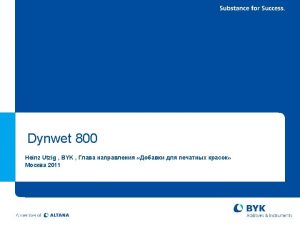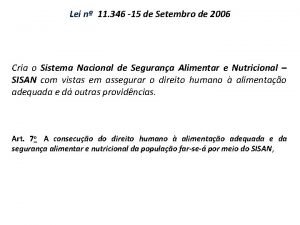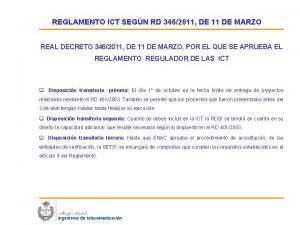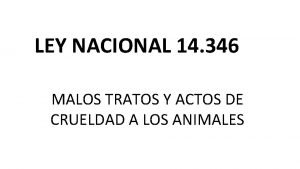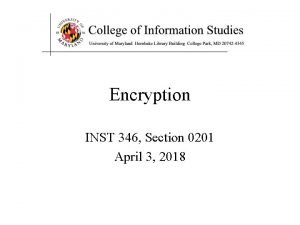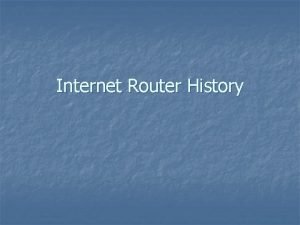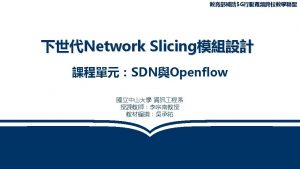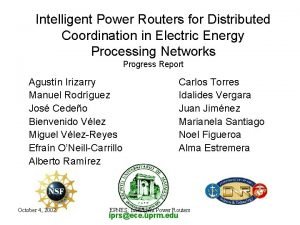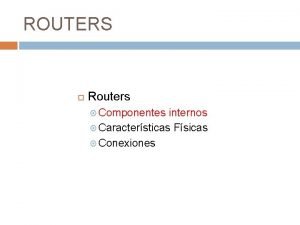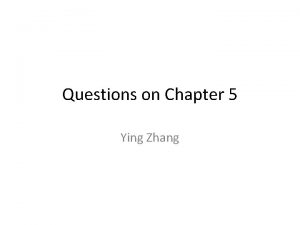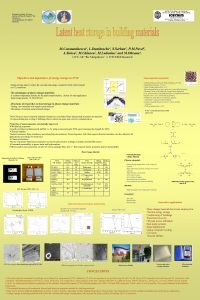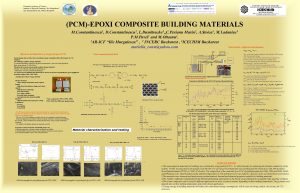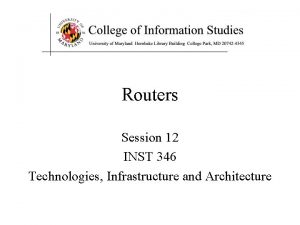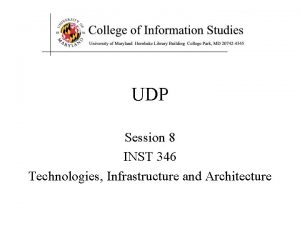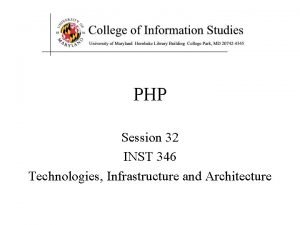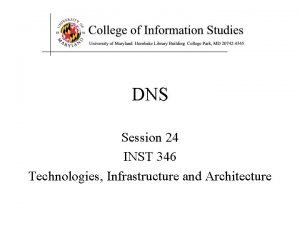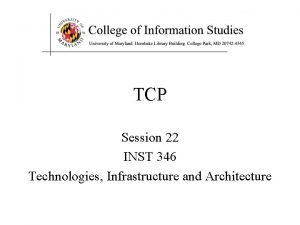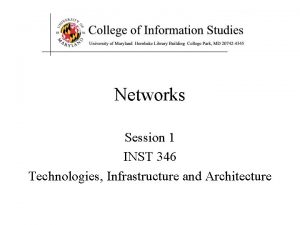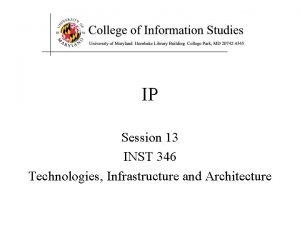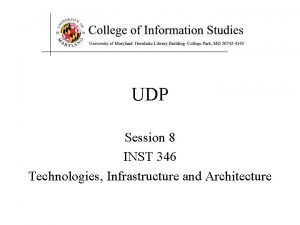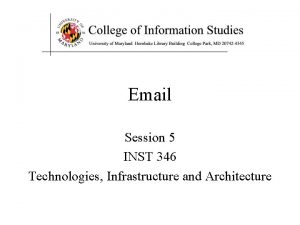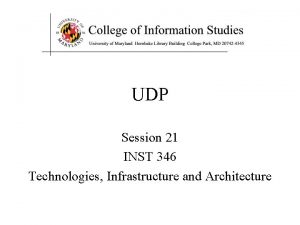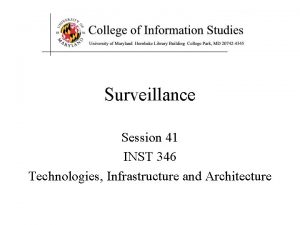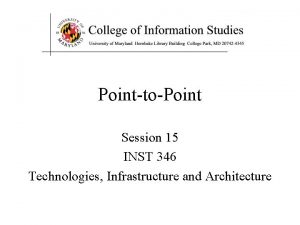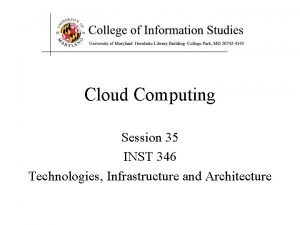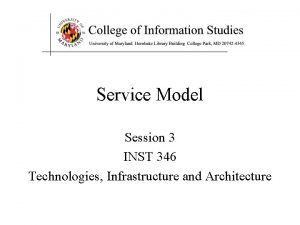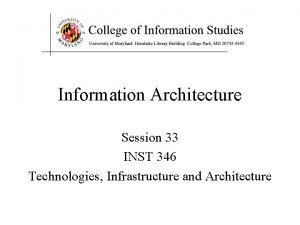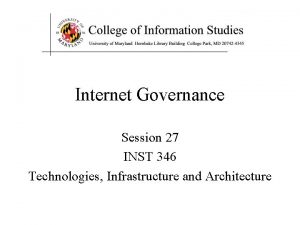Routers Session 12 INST 346 Technologies Infrastructure and


































- Slides: 34

Routers Session 12 INST 346 Technologies, Infrastructure and Architecture

Goals for Today • Finish up TCP – Flow control, timeout selection, close connection • Network layer overview • Structure of a router • Getahead: IPv 4 addresses

TCP segment structure 32 bits source port # ACK: ACK # valid sequence number acknowledgement number head not UAP R S F len used checksum RST, SYN, FIN: connection estab (setup, teardown commands) Internet checksum (as in UDP) dest port # receive window Urg data pointer options (variable length) application data (variable length) counting by bytes of data (not segments!) # bytes rcvr willing to accept

TCP flow control application may remove data from TCP socket buffers …. … slower than TCP receiver is delivering (sender is sending) application process application TCP socket receiver buffers TCP code IP code flow control receiver controls sender, so sender won’t overflow receiver’s buffer by transmitting too much, too fast from sender receiver protocol stack OS

TCP round trip time, timeout Q: how to set TCP timeout value? § longer than RTT • but RTT varies § too short: premature timeout, unnecessary retransmissions § too long: slow reaction to segment loss Q: how to estimate RTT? § Sample. RTT: measured time from segment transmission until ACK receipt • ignore retransmissions § Sample. RTT will vary, want estimated RTT “smoother” • average several recent measurements, not just current Sample. RTT

TCP round trip time, timeout Estimated. RTT = (1 - )*Estimated. RTT + *Sample. RTT § exponential weighted moving average § influence of past sample decreases exponentially fast § typical value: = 0. 125 RTT (milliseconds) RTT: gaia. cs. umass. edu to fantasia. eurecom. fr sample. RTT Estimated. RTT time (seconds)

TCP round trip time, timeout § timeout interval: Estimated. RTT plus “safety margin” • large variation in Estimated. RTT -> larger safety margin § estimate deviation from Estimated. RTT: Dev. RTTSample. RTT = (1 - )*Dev. RTT + *|Sample. RTT-Estimated. RTT| (typically, = 0. 25) Timeout. Interval = Estimated. RTT + 4*Dev. RTT estimated RTT * Check out the online interactive exercises for more examples: http: //gaia. cs. umass. edu/kurose_ross/interactive/ “safety margin”

TCP flow control § receiver “advertises” free buffer space by including rwnd value in TCP header of receiver-to-sender segments • Rcv. Buffer size set via socket options (typical default is 4096 bytes) • many operating systems autoadjust Rcv. Buffer § sender limits amount of unacked (“in-flight”) data to receiver’s rwnd value § guarantees receive buffer will not overflow to application process Rcv. Buffer rwnd buffered data free buffer space TCP segment payloads receiver-side buffering

TCP: closing a connection § client, server each close their side of connection • send TCP segment with FIN bit = 1 § respond to received FIN with ACK • on receiving FIN, ACK can be combined with own FIN § simultaneous FIN exchanges can be handled

TCP: closing a connection client state server state ESTAB client. Socket. close() FIN_WAIT_1 FIN_WAIT_2 can no longer send but can receive data FINbit=1, seq=x CLOSE_WAIT ACKbit=1; ACKnum=x+1 wait for server close FINbit=1, seq=y TIMED_WAIT timed wait for 2*max segment lifetime CLOSED can still send data LAST_ACK can no longer send data ACKbit=1; ACKnum=y+1 CLOSED

Network layer § transport segment from sending to receiving host § on sending side encapsulates segments into datagrams § on receiving side, delivers segments to transport layer § network layer protocols in every host, router § router examines header fields in all IP datagrams passing application transport network data link physical network data link physical network data link physical application transport network data link physical

Two key network-layer functions: analogy: taking a trip § forwarding: process of §forwarding: move getting through single packets from router’s interchange input to appropriate router output §routing: determine route § routing: process of taken by packets from planning trip from source to destination • routing algorithms

Network layer: data plane, control plane Data plane Control plane § local, per-router function § determines how datagram arriving on router input port is forwarded to router output port § forwarding function § network-wide logic § determines how datagram is routed among routers along end-end path from source host to destination host § two control-plane approaches: • traditional routing algorithms: implemented in routers • software-defined networking (SDN): implemented in (remote) servers values in arriving packet header 1 0111 3 2

Router architecture overview § high-level view of generic router architecture: routing processor routing, management control plane (software) operates in millisecond time frame forwarding data plane (hardware) operttes in nanosecond timeframe high-seed switching fabric router input ports router output ports

IP addressing: introduction § IP address: 32 -bit 223. 1. 1. 1 identifier for host, router interface 223. 1. 1. 2 § interface: connection between host/router and physical link 223. 1. 2. 1 223. 1. 1. 4 223. 1. 3. 27 223. 1. 1. 3 223. 1. 2. 2 • router’s typically have multiple interfaces • host typically has one or two interfaces (e. g. , wired Ethernet, wireless 802. 11) § IP addresses associated with each interface 223. 1. 2. 9 223. 1. 3. 2 223. 1. 1. 1 = 11011111 00000001 223 1 1 1

Subnets § IP address: • subnet part - high order bits • host part - low order bits § what’s a subnet ? • device interfaces with same subnet part of IP address • can physically reach other without intervening router 223. 1. 1. 1 223. 1. 1. 2 223. 1. 1. 4 223. 1. 1. 3 223. 1. 2. 1 223. 1. 2. 9 223. 1. 3. 27 223. 1. 2. 2 subnet 223. 1. 3. 2 network consisting of 3 subnets

IP addressing: CIDR: Classless Inter. Domain Routing • subnet portion of address of arbitrary length • address format: a. b. c. d/x, where x is # bits in subnet portion of address subnet part host part 11001000 00010111 00010000 200. 23. 16. 0/23

IP addresses: how to get one? Q: how does network get subnet part of IP addr? A: gets allocated portion of its provider ISP’s address space ISP's block 11001000 00010111 00010000 200. 23. 16. 0/20 Organization 1 Organization 2. . . 11001000 00010111 00010000 11001000 00010111 00010010 0000 11001000 00010111 00010100 0000 …. 200. 23. 16. 0/23 200. 23. 18. 0/23 200. 23. 20. 0/23 …. Organization 7 11001000 00010111 00011110 0000 200. 23. 30. 0/23

IP addressing: the last word. . . Q: how does an ISP get block of addresses? A: ICANN: Internet Corporation for Assigned Names and Numbers http: //www. icann. org/ • allocates addresses • manages DNS • assigns domain names, resolves disputes

Hierarchical addressing: route aggregation hierarchical addressing allows efficient advertisement of routing information: Organization 0 200. 23. 16. 0/23 Organization 1 200. 23. 18. 0/23 Organization 2 200. 23. 20. 0/23 Organization 7 . . . Fly-By-Night-ISP “Send me anything with addresses beginning 200. 23. 16. 0/20” Internet 200. 23. 30. 0/23 ISPs-R-Us “Send me anything with addresses beginning 199. 31. 0. 0/16”

IP datagram format IP protocol version number header length (bytes) “type” of data max number remaining hops (decremented at each router) upper layer protocol to deliver payload to how much overhead? v 20 bytes of TCP v 20 bytes of IP v = 40 bytes + app layer overhead 32 bits ver head. type of len service 16 -bit identifier upper time to layer live total datagram length (bytes) length fragment flgs offset header checksum for fragmentation/ reassembly 32 bit source IP address 32 bit destination IP address options (if any) data (variable length, typically a TCP or UDP segment) e. g. timestamp, record route taken, specify list of routers to visit.

Input port functions line termination link layer protocol (receive) lookup, forwarding switch fabric queueing physical layer: bit-level reception data link layer: e. g. , Ethernet decentralized switching: § using header field values, lookup output port using forwarding table in input port memory § goal: complete input port processing at ‘line speed’ § queuing: if datagrams arrive faster than forwarding rate into switch fabric

Destination-based forwarding table Destination Address Range Link Interface 11001000 00010111 00010000 through 11001000 00010111 1111 0 11001000 00010111 00011000 0000 through 11001000 00010111 00011000 1111 1 11001000 00010111 00011001 0000 through 11001000 00010111 00011111 2 otherwise 3 Q: but what happens if ranges don’t divide up so nicely?

Longest prefix matching longest prefix matching when looking forwarding table entry for given destination address, use longest address prefix that matches destination address. Destination Address Range Link interface 11001000 00010111 00010*** ***** 0 11001000 00010111 00011000 ***** 1 11001000 00010111 00011*** ***** 2 otherwise 3 examples: DA: 11001000 00010111 00010110 10100001 DA: 11001000 00010111 00011000 1010 which interface?

Longest prefix matching § longest prefix matching: often performed using ternary content addressable memories (TCAMs) • content addressable: present address to TCAM: retrieve address in one clock cycle, regardless of table size • Cisco Catalyst: can up ~1 M routing table entries in TCAM

Switching fabrics § transfer packet from input buffer to appropriate output buffer § switching rate: rate at which packets can be transfer from inputs to outputs • often measured as multiple of input/output line rate • N inputs: switching rate N times line rate desirable § three types of switching fabrics memory bus crossbar

Switching via a bus § datagram from input port memory to output port memory via a shared bus § bus contention: switching speed limited by bus bandwidth § 32 Gbps bus, Cisco 5600: sufficient speed for access and enterprise routers bus

Input port queuing § fabric slower than input ports combined -> queueing may occur at input queues • queueing delay and loss due to input buffer overflow! § Head-of-the-Line (HOL) blocking: queued datagram at front of queue prevents others in queue from moving forward switch fabric output port contention: only one red datagram can be transferred. lower red packet is blocked switch fabric one packet time later: green packet experiences HOL blocking

Output ports switch fabric datagram buffer queueing This slide in HUGELY important! link layer protocol (send) line termination § buffering required Datagram when datagrams (packets) can be lost arrive from fabric due faster than thelack of buffers to congestion, transmission rate § scheduling discipline chooses among Priority scheduling – who gets best performance, network neutrality queued datagrams for transmission

Output port queueing switch fabric at t, packets more from input to output switch fabric one packet time later § buffering when arrival rate via switch exceeds output line speed § queueing (delay) and loss due to output port buffer overflow!

How much buffering? § RFC 3439 rule of thumb: average buffering equal to “typical” RTT (say 250 msec) times link capacity C • e. g. , C = 10 Gpbs link: 2. 5 Gbit buffer § recent recommendation: with N flows, buffering equal to RTT. C N

Scheduling policies § scheduling: choose next packet to send on link § FIFO (first in first out) scheduling: send in order of arrival to queue • real-world example? • discard policy: if packet arrives to full queue: who to discard? • tail drop: drop arriving packet • priority: drop/remove on priority basis • random: drop/remove randomly packet arrivals queue link (waiting area) (server) packet departures

Scheduling policies Weighted Fair Queuing (WFQ): § generalized Round Robin § each class gets weighted amount of service in each cycle

Before You Go On a sheet of paper, answer the following (ungraded) question (no names, please): What one or two possible improvements to the way the class is being taught would make the most difference?
 It infrastructure and emerging technologies
It infrastructure and emerging technologies It infrastructure and emerging technologies
It infrastructure and emerging technologies Emerging technology chapter 2
Emerging technology chapter 2 It infrastructure and emerging technologies
It infrastructure and emerging technologies Computer hardware platforms in it infrastructure
Computer hardware platforms in it infrastructure High performance switches
High performance switches High performance core router
High performance core router Ist 346
Ist 346 Byk-345
Byk-345 Cranial nerves 346
Cranial nerves 346 Round off to the nearest hundred 695
Round off to the nearest hundred 695 Lei 11.346/2006
Lei 11.346/2006 Nearest ten thousand
Nearest ten thousand Rd 346 2011
Rd 346 2011 Stats-346
Stats-346 Ley 14 346
Ley 14 346 Cipher of 346
Cipher of 346 History of the router
History of the router Cisco rv220w network security firewall price
Cisco rv220w network security firewall price Business class routers
Business class routers Traditional network vs sdn
Traditional network vs sdn Three dumb routers
Three dumb routers Juniper ptx packet transport routers
Juniper ptx packet transport routers Routers
Routers Confidendial
Confidendial Routers.
Routers. Routers internos
Routers internos Consider three lans interconnected by two routers
Consider three lans interconnected by two routers Hnd routers
Hnd routers Systems integration specialists
Systems integration specialists Aafbr
Aafbr Rubiterm
Rubiterm Hresca inst
Hresca inst Apsit moodle
Apsit moodle Inst-154
Inst-154





